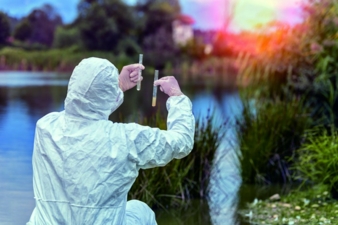15/06/2017 – 25 years of Oeko-Tex — auf Deutsch lesen
From REACH to Detox and beyond
Ten years ago the European Community Regulation on Chemicals [REACH] came into effect. What happened since this time?
The European Community Regulation on Chemicals [REACH] comes into effect on 01 June 2007. REACH stands for "Registration, Evaluation, Authorisation and Restriction of Chemicals" and fundamentally harmonises previous chemicals legislation. The goal is a high level of protection for people and the environment. REACH also obliges all actors in the entire supply chain for the textile and clothing industry to inform their buyers if the manufactured goods contain SVHC substances (Substances of Very High Concern) in a quantity of more than 0.1 percent weight by weight.
Corporate responsibility for products and manufacturing processes
In response to requests, this information obligation also applies to consumers. In the calculation of a found SVHC substance, the SVHC limit value refers to the examined single article and not the entire article. Since the REACH legislation took effect, the Oeko-Tex Association follows with particular interest both the identification and publication of SVHC substances in the REACH candidate list as well as developments in Annexes XVII and XIV of the REACH legislation. If new chemicals are included in the ECHA SVHC candidate list – and if the updates are not already taken into account in the Oeko-Tex criteria catalogue – an assessment is carried out by expert groups at the Oeko-Tex Association with regard to their relevance for fabrics, textiles, clothing or accessory parts. Developments classified as relevant are considered in updates to the Standard 100 by Oeko-Tex requirements as quickly and as effectively as possible. The same applies to developments in Annex XVII of REACH. A passage on REACH has been included in the Standard 100 certificate since 2007.
In the same year
In the same year, the American Apparel & Footwear Association (AAFA) publishes their first substance exclusion list (Restricted Substances List). In various cases, the Standard 100 test criteria act as a model for this exclusion list.
On 14 August 2008, the Consumer Product Safety Improvement Act (CPSIA) comes into effect in the USA. The wide-ranging legislation defines requirements for consumer goods imported into the USA and produced in the USA and has particular implications for many products aimed at children up to 12 years of age. With regard to the total lead content of children's articles, the CPSIA requirements are specifically included and taken into account as a criterion in the Standard 100; the limit values set in the Standard 100 are, from the start, even more stringent at 90 mg/kg and apply to all four product classes. In addition, Oeko-Tex has tested the lead and cadmium content that can be extracted with an artificial acidic sweat solution as well as many other heavy metals since as early as 1994.
One year after, on 13 August 2009, the American consumer association, the Consumer Products Safety Commission (CPSC), announces that children's textiles and textile-based products that are certified in accordance with the Standard 100 comply with the limit values for lead parts as defined in the Consumer Product Safety Improvement Act (CPSIA). The Oeko-Tex certificate also includes a reference to this American statutory requirement.
International Detox campaign
In 2011, Greenpeace starts its international Detox campaign. This aims to exclude from the textile production process eleven groups of chemica ls which can damage the environment and people. However, the original target of the investigations (waste water, sludge) is soon expanded by Greenpeace and, in the course of various studies (tests on textiles available from retailers), Greenpeace subsequently condemned the use of these "priority" chemicals for various product groups, particularly for outdoor clothing. The strategy pays off: industry, driven in particular by brands and retailers, reacts and initiates the Zero Discharge of Hazardous Chemicals (ZDHC) initiative in the same year. The self-imposed goal of this initiative is the complete elimination of those chemicals by 2020.
The Oeko-Tex Association provides targeted support to companies along the textile chain with regard to industry initiatives such as the Detox campaign or the restricted substances list for textile production (MRSL) from the ZDHC. Accordingly, since 2011, the Oeko-Tex Association has consciously included requirements of the Detox campaign and the ZDHC either as new additions to the requirements for different Oeko-Tex products or it has explicitly listed Oeko-Tex requirements that have been in existence for a long time in its requirements with reference to these initiatives to enable easier comparability. For example, poly- and perfluorinated compounds (PFCs), alkylphenol ethoxylates (APEOs) and nonylphenol were included in the Standard 100 test criteria at an early stage; various substances were already included by Oeko-Tex, even before the start of the Detox campaign.
Eco Passport and Detox to Zero
With the Eco Passport and Detox To Zero, since 2016 Oeko-Tex also provides two tools which companies in the textile industry can use to successfully tackle the growing challenges relating to transparent and responsible chemicals management. The Eco Passport is a two-stage verification process with which chemicals and auxiliaries can be tested with regard to human-ecological and environmental-ecological parameters even before they are used in textile production. Detox To Zero enables production facilities to analyse and optimise their chemicals management and also create clear documentation if they have committed to meeting the goals of the Detox campaign.
Exklusively researched for textile network by Oeko-Tex.





